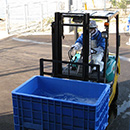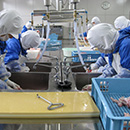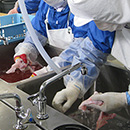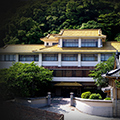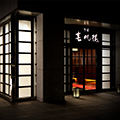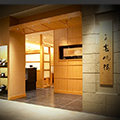- Top
- About Shunpanro
About Shunpanro
Michi Fujino, the landlady of Shunpanro, served fugu (blowfish) to Prince Ito Hirobumi, the first prime minister of Japan, who wanted to eat fish on a terribly stormy day in 1887. She was ready to be killed for punishment in doing so because it was prohibited to serve fugu in those days. This hospitality mind and eagerness to entertain customers are still conveyed in Shunpanro.
Origin and history
The story of origin of Shunpanro "Gen'yo and Michi"
The history of Shunpanro goes back all the way to the Edo period.
At the end of the Edo period, Fujino Gen’yo, a Western doctor who served the Okudaira clan in Buzen Nakatsu (Oita Prefecture), quit the job to study freely, and opened a clinic in Amidaiji-cho (the present location of Shunpanro) in Shimonoseki. While he specialized in ophthalmology, he also built herb baths and an entertainment ward for long-term care patients. To patients who wanted a drink, Gen’yo’s wife, Michi, served homemade dishes. It is said that Gen’yo selected this location because the Ito family, who had a residence next door, invited him. Ito Kyuzo, the head of the Ito family at that time, was a wealthy merchant who is also known for material and mental support to Sakamoto Ryoma.
In 1877, Gen’yo bought the site of an Amidaiji chamber, which had been abolished under the government order for the separation of Buddhism and Shintoism, and opened the Getsuharo Clinic anew. The history of Shunpanro started when Michi renovated this clinic and opened a restaurant-hotel with the advice of Ito Hirobumi around 1881 and 1882, after Gen’yo’s death.
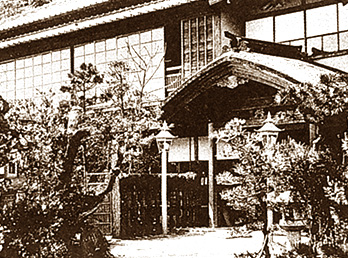
Former entrance to
Shunpanro in the Meiji Era
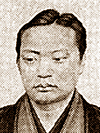
Fujino Gen'yo
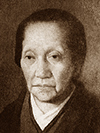
Fujino Michi
Shunpanro was named by Ito Hirobumi
Shimonoseki was also called "Bakan", and was a busy strategic position in the Kitamae sea route, compared to Naniwa in Osaka. Shimonoseki was also a base for the Choshu clan that aimed at bringing down the Edo shogunate. It is said that Ito Hirobumi, Takasugi Shinsaku, Yamagata Aritomo, and other spirits of the Meiji Restoration frequented this place, attracted by the personality of Gen’yo, who also participated in the Choshu War as an army doctor for Kiheitai and other armies.
The Kiheitai army was based in the Amidaiji temple (present Akama Jingu shrine), and was organized by Takasugi Shinsaku. Prince Ito Hirobumi later praised Takasugi Shinsaku as "moving like thunderbolt and starting like wind and rain" on the monument honoring him in Togyo-an, Yoshida. The present Shunpanro is built on the site of Amidaiji. The restaurant-hotel was named Shunpanro by Ito Hirobumi, after the view it commands, with many sailing ships floating on the calm spring sea.
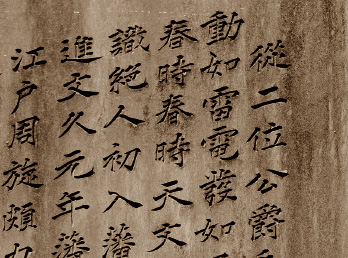
Monument honoring Takasugi Shinsaku in
Togyo-an, Yoshida
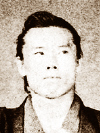
Ito Hirobumi
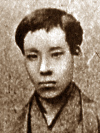
Takasugi Shinsaku
The prohibition on serving fugu (blowfish) dishes was lifted, and Shunpanro became the first publicly licensed restaurant to serve fugu.
At the end of 1887, Prince Ito Hirobumi, who was serving as the first prime minister in Japan at that time, stayed at Shunpanro. The sea was extremely stormy and there was no catch of fish at all. Michi was completely at a loss and decided to serve fugu dishes. She was ready to be killed for punishment in doing so because it was prohibited to serve fugu in those days. The prohibition on eating fugu was placed by Toyotomi Hideyoshi and was inherited until that time. As an increasing number of people were poisoned by fugu, the law stipulated that persons who eat fugu would be imprisoned and/or fined. However, such prohibitions were only formal, and common people in Shimonoseki always loved to eat fugu.
Prince Ito had known its taste because he once ate it together with Takasugi Shinsaku and others, but he pretended as if it had been his first time eating fugu, and praised it "This is wonderful!" In the following year, 1888, Ito ordered Hara Yasutaro, the then Governor of Yamaguchi, to lift the prohibition. Shunpanro thus became widely known as the first publicly licensed restaurant to serve fugu dishes.
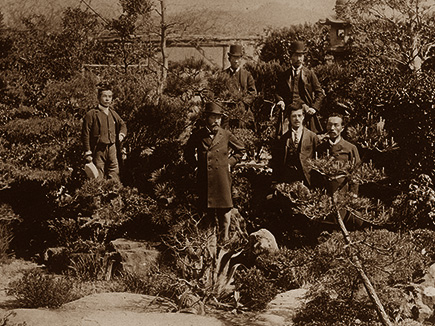
Former Shunpanro garden; second from left: Prince Ito Hirobumi
Shunpanro in the post-war period and in the future
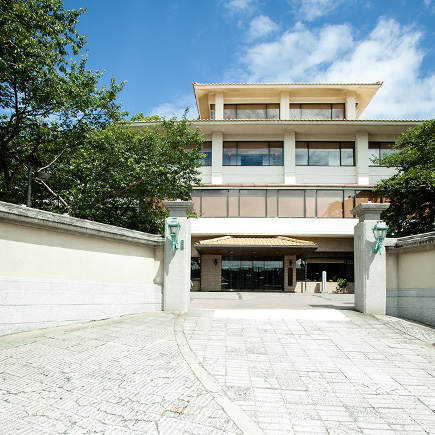
Present Shunpanro
-
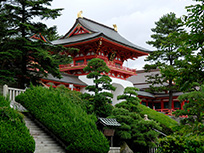
Akama Jingu shrine
-
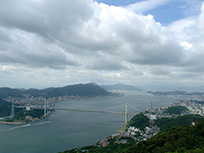
Kanmon Straits
Shunpanro burned down during the war in 1945, but was restored shortly after the end of the war. The Emperor and Empress Showa stayed with us when the Kanmon National Route Tunnel was completed and when the National Athletic Meet was held in Yamaguchi. The waves of lanterns held by residents filled throughout the national route along the coast through to the morning. The beautiful building as we see now, which shines in gold in the morning and evening, was fully renovated and reopened in December 1985.
fugu (blowfish) is listed at the top of dainty dishes from Shimonoseki and has fascinated gourmets throughout history. Since we were honored to be the first publicly licensed restaurant to serve fugu dishes, we have always taken pride in producing taste that suits that honor. As the guest house in Shimonoseki, Shunpanro has observed how dreams come and go in the course of history, and will continue to hand over this tradition to the future.
History of Shunpanro
| In 1888 | Shunpanro was awarded Japan's first restaurant license to serve blowfish. |
|---|---|
| In 1895 | The Shimonoseki Peace Treaty Conference between Japan and China was signed at a conference room in the hotel with prestigious dining. |
| In 1958 and 1963 | The Emperor and Empress Showa of Japan stayed as the honored guests of Shunpanro. |
Tiger puffer served at Shunpanro
Using safe materials for clear differentiation from competitors
Introduced a traceability system to identify the places of origin
In 2008, Shunpanro introduced a traceability system to trace back the places of production, development and origin of fugu (blowfish) that is cultivated in its own specifications. We never cease challenges to create one and only materials for clear differentiation from competitors through stable supply of safe materials.
Professional techniques
Three inherited techniques
-
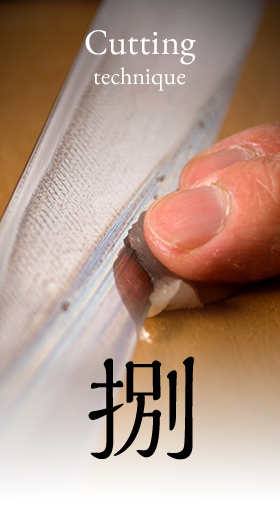
The key to our fugu (blowfish)sashi is the cutting skill that slices fugu so thinly that patterns on the plate can be seen through the meat. This skill of usuzukuri (thin slicing) is based on the tradition of the first publicly licensed restaurant to serve fugu dishes. This beautiful and delicate skill is enabled by careful preparation of materials. fugu meat is wrapped in a cloth after killing, and laid for one whole day and night under the confidential conditions, taking extreme care of time and temperature. This process tightens the meat well and induces the texture and flavor unique to fugu.
-
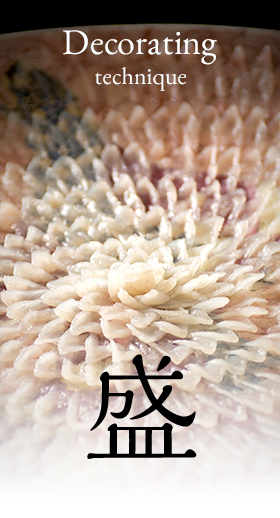
The decorative serving of thin slices with their edges standing is the way to appreciate fugu (blowfish) with your eyes. This sophisticated serving style is only possible with first-class skills and experience, combined with strictly selected materials and careful preparation. Our guests can enjoy the harmony of fugu with a beautiful plate decorated with professional ideas, such as gorgeous chrysanthemum serving, celebratory crane serving, etc.
-
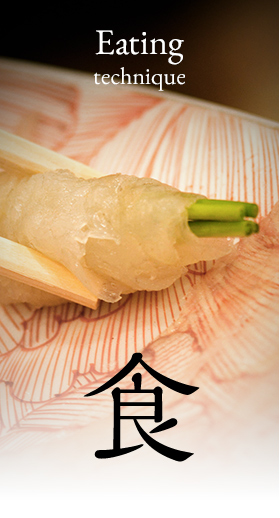
The eating style to wrap ultrafine crispy negi (green spring onion), specially cultivated for fugu (blowfish), with fugu meat, was originated in Shimonoseki. Enjoy it together with grated daikon(radish)with chile and special Ponzu sauce made by Shunpanro. The rich flavor of fresh negi, combined with the revitalizing sourness of ponzu, fills the mouth, and enhances the taste of fugu to a supremacy. Appreciate the wonderful taste in the Shunpanro style.
Carefully selected supporting actors
Ponzu sauce
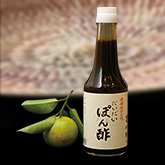
Early harvest of bitter orange that is grown in a contracted farmer in Itoshima, Fuguoka, is squeezed, and mixed in an excellent balance with additive-free, pure-brew soy sauce; Rausu kelp from Hokkaido; and dried bonito from Makurazaki, Kagoshima. The mild flavor unique to handmade ponzu enhances the taste of fugu (blowfish).
Yasuoka negi
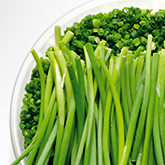
The ultrafine Koto negi(green onion) is indispensable as a condiment for fugu (blowfish). It is called "Yasuoka negi" in Shimonoseki and has been continuously improved in the Yasuoka district since Price Ito Hirobumi lifted the prohibition on eating fugu. We have tried negi from all parts of Japan and reached the conclusion that the soft, mellow and mild Yasuoka negi was the best.
Hospitality
Hospitality mind inherited to today
At the end of 1887, Prince Ito Hirobumi, the first prime minister in Japan, wanted to eat fish on a terribly stormy day, when there was no catch of fish at all. The then landlady, Michi, decided to serve fugu (blowfish) dishes. She was ready to be killed for punishment in doing so because it was prohibited to serve fugu in those days. She wanted to do her best to entertain Ito with nice dishes. Thus the history of Shunpanro started with her hospitality mind.
Caring about guests –
First of all, we care about and entertain guests with dainty dishes.
The decision and preparedness of Michi is still conveyed in Shunpanro at this moment.
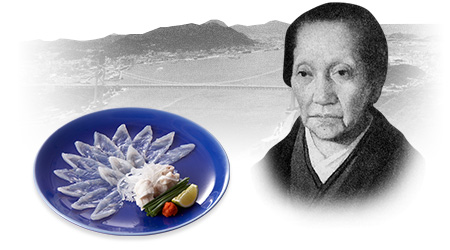
Three policies for "Omotenashi" at Shunpanro
-
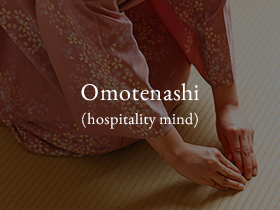
- "Omotenashi (spirit of hospitality)" means that there is no omote (it is not an official stance), but only honest, natural behavior and mind. Without becoming too conspicuous or too scarce, we entertain guests with reassuring and friendly service that helps guests focus on the dishes.
-
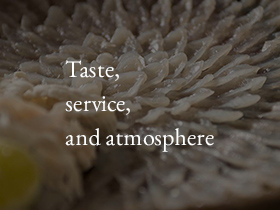
- Dishes that feature seasonal materials unique to Japan, and reassuring and friendly service that help guests focus on the dishes – we honestly entertain guests in a calm and pleasant atmosphere.
-
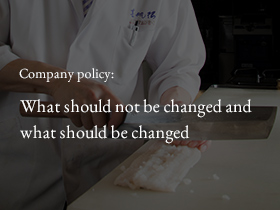
- We at Shunpanro have a long history and many things to be handed down. While we preserve the tradition, we must also keep changing many things for more enhanced satisfaction of guests. Over time, we keep improving ourselves.
Shunpanro across JapanFugu (blowfish) and seasonal dishes
Shunpanro across Japan
